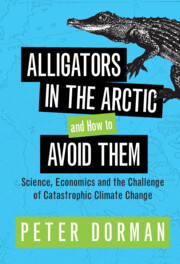 Alligators in the Arctic and How to Avoid Them
Alligators in the Arctic and How to Avoid Them Book contents
- Alligators in the Arctic and How to Avoid Them
- Alligators in the Arctic and How to Avoid Them
- Copyright page
- Dedication
- Contents
- Figures, Maps and Tables
- Preface
- Introduction
- 1 Carbon Accounting for Planet Earth
- 2 The Risks of Climate Change, or Why Carbon Budgets Need to Be Binding
- 3 Measurement
- 4 It’s about Fossil Fuels
- 5 Costs and Consequences
- 6 The Carbon Policy Toolkit
- 7 The Global Dimension
- 8 Political Economy for Alligators
- Appendix: Demystifying the Economics of Climate Change
- Notes
- References
- Index
3 - Measurement
Myths and Distractions
Published online by Cambridge University Press: 14 July 2022
- Alligators in the Arctic and How to Avoid Them
- Alligators in the Arctic and How to Avoid Them
- Copyright page
- Dedication
- Contents
- Figures, Maps and Tables
- Preface
- Introduction
- 1 Carbon Accounting for Planet Earth
- 2 The Risks of Climate Change, or Why Carbon Budgets Need to Be Binding
- 3 Measurement
- 4 It’s about Fossil Fuels
- 5 Costs and Consequences
- 6 The Carbon Policy Toolkit
- 7 The Global Dimension
- 8 Political Economy for Alligators
- Appendix: Demystifying the Economics of Climate Change
- Notes
- References
- Index
Summary
Absent effective public action, attention has shifted to what individuals and organizations can do on their own, using carbon audits and footprint estimates to pursue the goal of neutrality. Unfortunately, economics long ago demonstrated that the calculation of “physical” prices like embodied carbon is forbiddingly complex and that the interconnectedness of our decision-making makes it impossible to decompose social outcomes into separate individual choices. This is illustrated in case studies of electric versus internal combustion-powered vehicles and the carbon accounting exercises of Microsoft and a public university. Meanwhile, governments have been preoccupied with setting emission targets slated to be reached decades in the future. At best, they have only a loose relationship to the cumulative emissions that drive climate change. The solution is to switch to carbon budgets, limits on total future emissions. Calculation of budgets compatible with 1.5°C or 2°C warming can be only approximate, but climate scientists have given us reasonable estimates. A useful benchmark is the corresponding emission cuts under the simplification of equal annual reductions. This equals 3.5% globally for a 2° target. Social justice and political realism call for much larger percentage cuts in rich nations’ emissions, perhaps about 5% per year.
Keywords
- Type
- Chapter
- Information
- Alligators in the Arctic and How to Avoid ThemScience, Economics and the Challenge of Catastrophic Climate Change, pp. 53 - 79Publisher: Cambridge University PressPrint publication year: 2022
